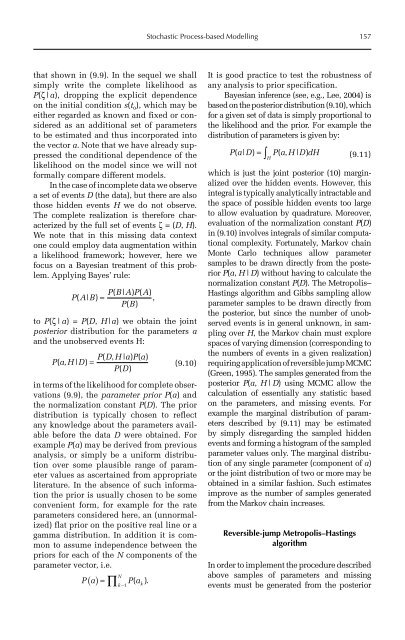Redesigning Animal Agriculture
Redesigning Animal Agriculture
Redesigning Animal Agriculture
You also want an ePaper? Increase the reach of your titles
YUMPU automatically turns print PDFs into web optimized ePapers that Google loves.
that shown in (9.9). In the sequel we shall<br />
simply write the complete likelihood as<br />
P(ζ |a), dropping the explicit dependence<br />
on the initial condition s(t 0), which may be<br />
either regarded as known and fixed or considered<br />
as an additional set of parameters<br />
to be estimated and thus incorporated into<br />
the vector a. Note that we have already suppressed<br />
the conditional dependence of the<br />
likelihood on the model since we will not<br />
formally compare different models.<br />
In the case of incomplete data we observe<br />
a set of events D (the data), but there are also<br />
those hidden events H we do not observe.<br />
The complete realization is therefore characterized<br />
by the full set of events ζ = (D, H).<br />
We note that in this missing data context<br />
one could employ data augmentation within<br />
a likelihood framework; however, here we<br />
focus on a Bayesian treatment of this problem.<br />
Applying Bayes’ rule:<br />
PBAPA ( | ) ( )<br />
PAB ( | ) =<br />
,<br />
PB ( )<br />
to P(ζ |a) = P(D, H|a) we obtain the joint<br />
posterior distribution for the parameters a<br />
and the unobserved events H:<br />
PDHaPa<br />
( , | ) ( )<br />
PaH (, | D)<br />
= (9.10)<br />
PD ( )<br />
in terms of the likelihood for complete observations<br />
(9.9), the parameter prior P(a) and<br />
the normalization constant P(D). The prior<br />
distribution is typically chosen to reflect<br />
any knowledge about the parameters available<br />
before the data D were obtained. For<br />
example P(a) may be derived from previous<br />
analysis, or simply be a uniform distribution<br />
over some plausible range of parameter<br />
values as ascertained from appropriate<br />
literature. In the absence of such information<br />
the prior is usually chosen to be some<br />
convenient form, for example for the rate<br />
parameters considered here, an (unnormalized)<br />
flat prior on the positive real line or a<br />
gamma distribution. In addition it is common<br />
to assume independence between the<br />
priors for each of the N components of the<br />
parameter vector, i.e.<br />
N<br />
P( a) = ∏ P( ak). k −1<br />
Stochastic Process-based Modelling 157<br />
It is good practice to test the robustness of<br />
any analysis to prior specification.<br />
Bayesian inference (see, e.g., Lee, 2004) is<br />
based on the posterior distribution (9.10), which<br />
for a given set of data is simply proportional to<br />
the likelihood and the prior. For example the<br />
distribution of parameters is given by:<br />
PaD (| ) = ∫ PaH (, | DdH )<br />
(9.11)<br />
H<br />
which is just the joint posterior (10) marginalized<br />
over the hidden events. However, this<br />
integral is typically analytically intractable and<br />
the space of possible hidden events too large<br />
to allow evaluation by quadrature. Moreover,<br />
evaluation of the normalization constant P(D)<br />
in (9.10) involves integrals of similar computational<br />
complexity. Fortunately, Markov chain<br />
Monte Carlo techniques allow parameter<br />
samples to be drawn directly from the posterior<br />
P(a, H|D) without having to calculate the<br />
normalization constant P(D). The Metropolis–<br />
Hastings algorithm and Gibbs sampling allow<br />
parameter samples to be drawn directly from<br />
the posterior, but since the number of unobserved<br />
events is in general unknown, in sampling<br />
over H, the Markov chain must explore<br />
spaces of varying dimension (corresponding to<br />
the numbers of events in a given realization)<br />
requiring application of reversible jump MCMC<br />
(Green, 1995). The samples generated from the<br />
posterior P(a, H|D) using MCMC allow the<br />
calculation of essentially any statistic based<br />
on the parameters, and missing events. For<br />
example the marginal distribution of parameters<br />
described by (9.11) may be estimated<br />
by simply disregarding the sampled hidden<br />
events and forming a histogram of the sampled<br />
parameter values only. The marginal distribution<br />
of any single parameter (component of a)<br />
or the joint distribution of two or more may be<br />
obtained in a similar fashion. Such estimates<br />
improve as the number of samples generated<br />
from the Markov chain increases.<br />
Reversible-jump Metropolis–Hastings<br />
algorithm<br />
In order to implement the procedure described<br />
above samples of parameters and missing<br />
events must be generated from the posterior










